Kristine Hughes's Blog, page 134
December 24, 2011
Raising a Toast to Christmas
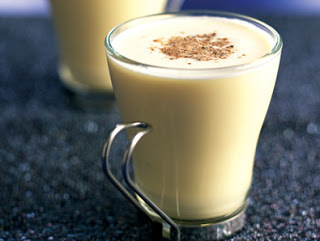
The grocery store Trader Joe's recomends egg nog for Christmas in its Holiday Guide 2011. We all love the rich mix, whether or not it is laced with whiskey or rum. The Guide notes that there are some things among our food and drink traditions that are closely associated with the holidays every year. One version of eggnog's origin is from the English area of East Anglia where a noggin is a small mug. There are other explanations, but this one is probably as good as any. Yum.

The picture above accompanies Rachel Ray's recipe(s) for EggNog. Try one of them here. Ray suggests rum to add a touch of cheer to the traditional egg, cream and nutmeg ingredients.
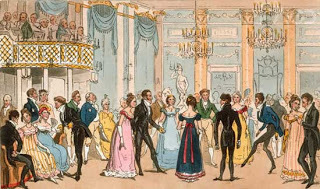
I remember my parrents serving Tom and Jerrys many years ago at the holidays. I thought they meant the cat and mouse cartoon characters, but the drink was invented by Pierce Egan (1772-1849), creator of the regency era ne-er-do-wells Tom and Jerry, whose Life in London ran to many editions in the 19th century. The cat and mouse were named after them too. Egan was a journalist and sportswriter, and his silly characters had many adventures. Above, they manage to enter Almack's, where they probably would not find any alcohol, unless it was smuggled in by a regency rake. Though there are many variations, a Tom and Jerry resembles eggnog.
 For a recipe, click this link.
For a recipe, click this link.As long as I was looking into Christmas cheer, I looked up wassail. I've sung about going wassailing for years in the well-known carol -- and never stopped to wonder what in the world it meant.
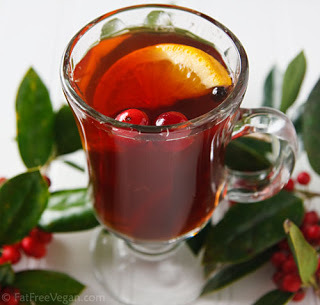
Here is an recipe based on fruit juices and without alcohol.
Appropriately, there are many recipes for wassail or wassail punch, though all seem to have a apple cider base. According to several sources, wassailing was a group activity involving singing and saluting the health of the apple trees to encourage a good harvest in the future. Wouldn't this just be a good excuse for a party? Wassailing could be done at harvest time in the fall, particularly in the south of England where the apple orchards prevail, and at Christmas time, though the roots of the custom seem to go back to pre-Christian days in England. For ale-based and wine-laced recipes and more, click here.
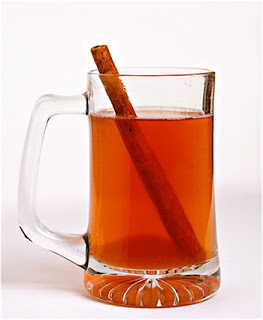
Another popular warm drink for the holidays is the Hot Toddy, usually made with a lemon-juice base. As in all of the above, alcohol is optional. I note than many examples carry a cinnamon stick as a stir. To repeat, yum. Some sources say the Scottish version is usually made with whisky and the English version with strong black tea. For recipes, click here.
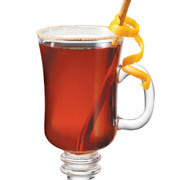
There are many more Christmas drinks, both traditional and cutting-edge. Think hot buttered rum, mulled wine and/or cider, hot chocolate, or Irish Coffee. Or try Bishop, a warm wine-based drink mixed by Scrooge in Charles Dickens' Christmas Carol.
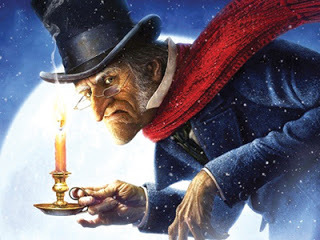
So here's to you, a virtual cup of good cheer for the holidays!!
[image error]
Published on December 24, 2011 01:00
December 22, 2011
Sherlock Holmes: A Game of Shadows
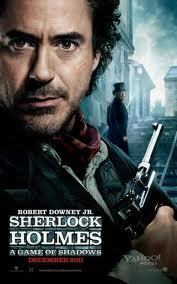
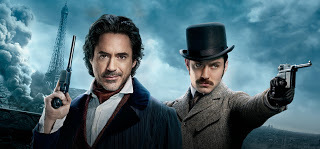
In this sequel, Sherlock Holmes and his sidekick Dr. Watson join forces to outwit and bring down their fiercest adversary, Professor Moriarty, played by Jared Harris, below.
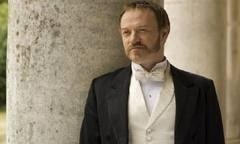
Stephen Fry is Mycroft Holmes, elder brother of Sherlock.
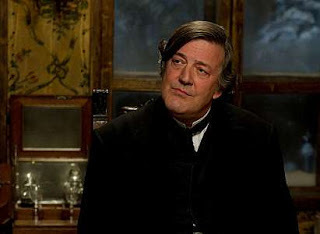
And then, of course, there are Robert Downey, Jr. and Jude Law -
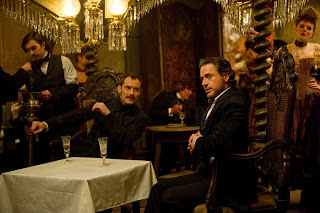
This cast alone should be more than enough encouragement to see the film, but should you be the odd man out and need even more incentive, Wikipedia offers this plot synopsis: "Sherlock Holmes (Robert Downey, Jr.) has always been the smartest man in the room…until now. There is a new criminal mastermind at large—Professor James Moriarty (Jared Harris)—and not only is he Holmes' intellectual equal, but his capacity for evil, coupled with a complete lack of conscience, may actually give him an advantage over the renowned detective. When the Crown Prince of Austria is found dead, the evidence, as construed by Inspector Lestrade (Eddie Marsan), points to suicide. But Sherlock Holmes deduces that the prince has been the victim of murder—a murder that is only one piece of a larger and much more portentous puzzle, designed by one Professor Moriarty. Mixing business with pleasure, Holmes tracks the clues to an underground gentlemen's club, where he and his brother, Mycroft Holmes (Stephen Fry) are toasting Dr. Watson (Jude Law) on his last night of bachelorhood. It is there that Holmes encounters Sim (Noomi Rapace), a Gypsy fortune teller, who sees more than she is telling and whose unwitting involvement in the prince's murder makes her the killer's next target. Holmes barely manages to save her life and, in return, she reluctantly agrees to help him. The investigation becomes ever more dangerous as it leads Holmes, Watson and Sim across the continent, from England to France to Germany and finally to Switzerland. But the cunning Moriarty is always one step ahead as he spins a web of death and destruction—all part of a greater plan that, if he succeeds, will change the course of history." Yowza!
Watch the trailer here.
Published on December 22, 2011 00:24
December 20, 2011
The Origins of the Christmas Card
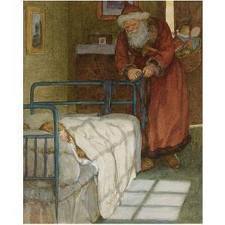
From Christmas Cards & Their Chief Designers By Gleeson White (1894)
The origin of the Christmas card is, fortunately for its future historians, not lost in the mists of antiquitv, that popular hiding place for all sorts of origins; but as clearly fixed as Archbishop Usher's date of Creation- B.c. 4004, October 26, 4-30 p.m.,—with more trustworthy evidence to support it. In 1846, Sir Henry Cole (then plain Mr) suggested the idea of a specially designed form of greeting to send to friends at Christmas. Mr J. C. Hor.«!ey, R.A., acting on the hint, produced a design of a trellis of rustic-work, in the Germanesque style, divided into a centre and two side panels. In the panels are figures representing two of the acts of charity, "feeding the hungry" and "clothing the naked;" in the centre is a picture of a merry family party, including three generations, grandparents to grandchildren, quaffing draughts of wine.
![[graphic][merged small][ocr errors]](https://i.gr-assets.com/images/S/compressed.photo.goodreads.com/hostedimages/1387703601i/7654805.jpg)
It was evident that some such individual, whether called buyer or commercial traveller, comes between the manufacturer and the retailer in almost every instance. Not only has this personage to reckon with the taste of shop-keepers, which varies from the best to the worst, with a tendency to the latter, but he has also his own standard to defend. Hence he sells most readily not only those goods the average retail trader is most likely to choose for himself, but a great many others which, since they approve themselves to the vendor, he can recommend with sincerity.It is strange that this needle's eye, through which so much Applied Art has to pass ere it reaches the public, is not more often recognised as the chief obstacle to its progress. The public should not be held responsible for declining to purchase goods which never came under its eyes; the manufacturer should not be held blameworthy for the poor level of the Art he offers, when, possibly, he has tried and tried in vain to induce his travellers and the trade buyers to support his efforts to produce good designs.
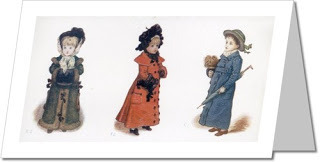
![[graphic]](https://i.gr-assets.com/images/S/compressed.photo.goodreads.com/hostedimages/1387703601i/7654807.jpg) Although 1846 has been so far accepted as the undisputed date of the first card, just before going to press, Mr Jonathan King, the owner of the largest collection, has called my attention to a paragraph in a journal'of some standing, where a Mr Thomas Shorrock, of Leith, is said to be the real inventor of the Christmas card, seeing that a year or two before the above date he issued one, with a laughing face, and the motto "A Gude New Year to Ye." Whether this be the card which is elsewhere said to have been engraved on a copper- plate by a workman, Daniel Aikman, in 1840 or 1841 and published with a Scotch motto, I am unable to prove. Should either of these statements be accurate, although one might, without special pleading, claim that a New Year secular greeting is not quite the same as one marking a religious festival, it would be best to give later inventors equal credit, and assume, what would be probably correct, that neither knew of the doings of the others. So, too, the statement that engravers' apprentices of Northumberland or Yorkshire (the stories differ, and one questions if such a class of artists exists in either place in sufficient numbers to found a custom), are in the habit of sending specimens of their own work to friends at Christmas, and have done so for a long period, may or may not be true, but is hardly likely to have been the source whence the card was derived. Equally difficult is it to obtain any details of Messrs Goodall's cards in 1862 (or 1864, authorities vary,) which were probably the first issued to the ordinary trade. Despite a former sentence crediting Messrs Goodall with the honour of being the first publishers of Christmas cards, (always excepting the Sir Henry Cole card of 1846,) and, notwithstanding the fact that several of their cards, issued in 1864 and 1865, from designs by C. H. Bennett, are reproduced here, it is possible that other candidates might put forward reasonable claims. It seems probable that ornamented note paper and envelopes appeared just before the cards, that the designs in relief, identical with those on the stationery named, were either simultaneously or very shortly after stamped in the centre of a card, which had its edges coloured or embossed. Certain it is that T. Sulman was very early in the field with relief-decorated paper and cards, and with lithographed designs. Leighton, of Fleet Street, and Mansell, of Red Lion Square, are also amongst the first, while R. Canton, (who started Valentine and Birthday card production in 1840,) and Dean & Sons issued many of their publications with special Christmas mottoes. The innovation of stamping reliefs in two or more colours is dated to 1858. The introduction of foreign "chromo-lithograph pictures," to replace those hitherto coloured by hand, or by stencil, is traced to Elliott, of Bucklesbury, in 1850, and to Scheffer and Scheiper, (I have but the phonetic spelling of these names,) in 1851. This item in the preparation of "made-up" Birthday Cards and Valentines had hitherto been very rudely prepared by colouring plain embossed relief with a brush, or stencilling lithographs, afterwards embossed and cut out.
Although 1846 has been so far accepted as the undisputed date of the first card, just before going to press, Mr Jonathan King, the owner of the largest collection, has called my attention to a paragraph in a journal'of some standing, where a Mr Thomas Shorrock, of Leith, is said to be the real inventor of the Christmas card, seeing that a year or two before the above date he issued one, with a laughing face, and the motto "A Gude New Year to Ye." Whether this be the card which is elsewhere said to have been engraved on a copper- plate by a workman, Daniel Aikman, in 1840 or 1841 and published with a Scotch motto, I am unable to prove. Should either of these statements be accurate, although one might, without special pleading, claim that a New Year secular greeting is not quite the same as one marking a religious festival, it would be best to give later inventors equal credit, and assume, what would be probably correct, that neither knew of the doings of the others. So, too, the statement that engravers' apprentices of Northumberland or Yorkshire (the stories differ, and one questions if such a class of artists exists in either place in sufficient numbers to found a custom), are in the habit of sending specimens of their own work to friends at Christmas, and have done so for a long period, may or may not be true, but is hardly likely to have been the source whence the card was derived. Equally difficult is it to obtain any details of Messrs Goodall's cards in 1862 (or 1864, authorities vary,) which were probably the first issued to the ordinary trade. Despite a former sentence crediting Messrs Goodall with the honour of being the first publishers of Christmas cards, (always excepting the Sir Henry Cole card of 1846,) and, notwithstanding the fact that several of their cards, issued in 1864 and 1865, from designs by C. H. Bennett, are reproduced here, it is possible that other candidates might put forward reasonable claims. It seems probable that ornamented note paper and envelopes appeared just before the cards, that the designs in relief, identical with those on the stationery named, were either simultaneously or very shortly after stamped in the centre of a card, which had its edges coloured or embossed. Certain it is that T. Sulman was very early in the field with relief-decorated paper and cards, and with lithographed designs. Leighton, of Fleet Street, and Mansell, of Red Lion Square, are also amongst the first, while R. Canton, (who started Valentine and Birthday card production in 1840,) and Dean & Sons issued many of their publications with special Christmas mottoes. The innovation of stamping reliefs in two or more colours is dated to 1858. The introduction of foreign "chromo-lithograph pictures," to replace those hitherto coloured by hand, or by stencil, is traced to Elliott, of Bucklesbury, in 1850, and to Scheffer and Scheiper, (I have but the phonetic spelling of these names,) in 1851. This item in the preparation of "made-up" Birthday Cards and Valentines had hitherto been very rudely prepared by colouring plain embossed relief with a brush, or stencilling lithographs, afterwards embossed and cut out. 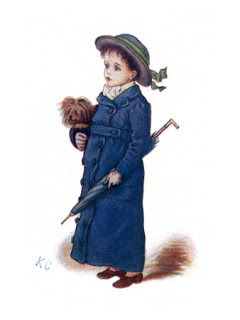 An improvement in these devices is traced to a man whose professional occupation was to colour designs upon linen bands for the Irish trade. These cut out devices were prepared at a cost of 4d. per 1,000, the hands earning about 15s. a week, until Germany sent over more cheaply produced imitations at one-sixteenth of the cost. Thierry, of Fleet Street, known as the father of the Christmas card trade, was, doubtless, the first to introduce the elaborately embossed reliefs which afterwards came over in cart loads. Then they cost 8os. per 100 sheets, now their price has fallen to is. the 100 for large quantities. When one remembers that at first—and for many years after- a large majority of the cards, (which, however little they interest us here, helped to spread the fashion), were made up from foreign chromo-lithographs, even by firms of the high standing of Marcus Ward, we find that this importation of foreign embossed relief takes its place as an important commercial factor in the rise of the industry.
An improvement in these devices is traced to a man whose professional occupation was to colour designs upon linen bands for the Irish trade. These cut out devices were prepared at a cost of 4d. per 1,000, the hands earning about 15s. a week, until Germany sent over more cheaply produced imitations at one-sixteenth of the cost. Thierry, of Fleet Street, known as the father of the Christmas card trade, was, doubtless, the first to introduce the elaborately embossed reliefs which afterwards came over in cart loads. Then they cost 8os. per 100 sheets, now their price has fallen to is. the 100 for large quantities. When one remembers that at first—and for many years after- a large majority of the cards, (which, however little they interest us here, helped to spread the fashion), were made up from foreign chromo-lithographs, even by firms of the high standing of Marcus Ward, we find that this importation of foreign embossed relief takes its place as an important commercial factor in the rise of the industry.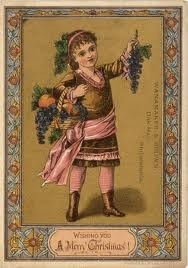 A Greenaway Christmas Card
A Greenaway Christmas Card![[graphic][ocr errors][ocr errors]](https://i.gr-assets.com/images/S/compressed.photo.goodreads.com/hostedimages/1387703601i/7654810.jpg) With Messrs Marcus Ward & Co., who started the production of Christmas cards as early as 1867, coincidentally with the opening of their London house, however, we come to a very different class of manufacturers. Here is a house, one of the earliest in production, with a record that reaches the highest level of decorative excellence ever touched by the Christmas card. This firm for awhile monopolised the whole of the better-class trade. Beginning with the use of German " chromos," usually mounted on card with lithographed borders in gold and colours, of home manufacture, they soon issued reproductions of original designs by artists of repute, and gained a position where they stood without rivals. It was, I believe, owing to the *acute perception of one of the partners of this firm, Mr. William H. Ward, that Miss Kate Greenaway was "discovered" as a designer. At the earliest "Black and White" Exhibition at the Dudley Gallery Mr. Ward's attention was drawn to Miss Greenaway's work; and recognising that her special talent was in the direction of costume figures and dainty colours, he induced her to design for the firm.It is this characteristic which must be reckoned to the honour of Marcus Ward's cards; not because they employed celebrated artists more freely than other firms—capable designers indeed were commissioned, but their list of well-known painters will not compare in mere numbers for a moment with those of several of their near rivals—but because they saw that an architectural, not a pictorial, aim was the correct one. To talk of architecture in connection with so ephemeral an object as a Christmas card may sound absurd, but, nevertheless, I think all students of decoration must admit that its treatment should be more nearly allied to the surface decoration of buildings than to transcripts of nature, which are, in theory, attempts to imitate the out-look from a window of the building. This latter, usually held to be the aim of the pictorial artist, cannot be employed without degradation upon mechanically-produced reproductions in colour; but the artificial convention — the idea of decorative as distinguished from pictorial art— wherever you find it for stained glass, mosaic, enamel, inlay or colour printing, has another purpose to fulfil, which is more admirably achieved when the limitations of the material are duly observed.
With Messrs Marcus Ward & Co., who started the production of Christmas cards as early as 1867, coincidentally with the opening of their London house, however, we come to a very different class of manufacturers. Here is a house, one of the earliest in production, with a record that reaches the highest level of decorative excellence ever touched by the Christmas card. This firm for awhile monopolised the whole of the better-class trade. Beginning with the use of German " chromos," usually mounted on card with lithographed borders in gold and colours, of home manufacture, they soon issued reproductions of original designs by artists of repute, and gained a position where they stood without rivals. It was, I believe, owing to the *acute perception of one of the partners of this firm, Mr. William H. Ward, that Miss Kate Greenaway was "discovered" as a designer. At the earliest "Black and White" Exhibition at the Dudley Gallery Mr. Ward's attention was drawn to Miss Greenaway's work; and recognising that her special talent was in the direction of costume figures and dainty colours, he induced her to design for the firm.It is this characteristic which must be reckoned to the honour of Marcus Ward's cards; not because they employed celebrated artists more freely than other firms—capable designers indeed were commissioned, but their list of well-known painters will not compare in mere numbers for a moment with those of several of their near rivals—but because they saw that an architectural, not a pictorial, aim was the correct one. To talk of architecture in connection with so ephemeral an object as a Christmas card may sound absurd, but, nevertheless, I think all students of decoration must admit that its treatment should be more nearly allied to the surface decoration of buildings than to transcripts of nature, which are, in theory, attempts to imitate the out-look from a window of the building. This latter, usually held to be the aim of the pictorial artist, cannot be employed without degradation upon mechanically-produced reproductions in colour; but the artificial convention — the idea of decorative as distinguished from pictorial art— wherever you find it for stained glass, mosaic, enamel, inlay or colour printing, has another purpose to fulfil, which is more admirably achieved when the limitations of the material are duly observed.
Published on December 20, 2011 01:18
December 17, 2011
On The Shelf: Annie Groves
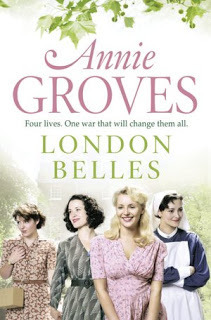
Recently, I was given that which every avid reader covets - the gift of discovering a new author. Annie Groves, who also writes as Penny Jordan. Her writing style is reminiscent of Catherine Cookson and Groves also writes family sagas, most of them being set around World War II London, rather than 19th century Tyne and Wear. Her latest series begins with London Belles, a tale of four very different young women thrown together by war. Finding freedom and independence – as well as love, passion and heartbreak – for the very first time, a unique bond is formed as the hostilities take their toll on Britain.
United by chance, bound together in times of need When tragedy strikes, Olive is forced to seek lodgers. Three girls come knocking at her door, each in need of a roof over their heads. Sally has left Liverpool to work as a nurse in London and when she arrives she is a shell of her former self. Where once stood a vivacious, sociable girl, now stands one plagued by homesickness and a betrayal that is devastatingly fresh in her mind. Dulcie is living the high life in the West End, a world away from her home in Stepney. Working at Selfridges gives her access to the most fashionable clothes and makeup, but at home she is the black sheep of the family; always second to her sister. So she decides it's time to make a bid for freedom. Agnes grew up in an orphanage, having been left on the steps as a new-born baby. But with war looming, and the orphanage relocating to the country, she must now seek out a job and lodgings. But with change comes exciting new opportunities, worlds away from the life she's known… As the women prepare for war, all of their futures hang in the balance. Soon their lives will change irrevocably and the home that binds the London Belles is no longer the sanctuary they once sought.
Imagine my delight when, upon finishing London Belles, I rushed to the Barnes and Noble site only to find that there's already a sequel, Home for Christmas, which picks up the tale exactly where it left off.
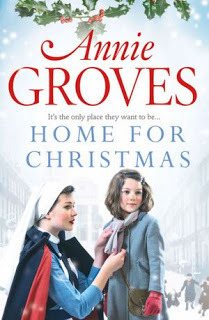
There's nothing new or shocking in Groves's storytelling, but that's a good thing. She uses a gentle voice to relay the wants, desires and motivations of four 1940's girls, each of whom has their own distinct personality. Like Cookson, Groves charms the reader with good, old fashioned storytelling that left me wanting more. Best of all, Groves has a couple of previous WWII series in her backlist, so I'll have a title of hers in my TBR pile for a while to come. You can visit Annie Groves' website here.
Published on December 17, 2011 22:27
December 16, 2011
Jane Austen's 236th Birthday December 16, 2011
On Saturday, December 10, the Wisconsin region of JASNA celebrated Jane Austen's birthday with a gala luncheon.
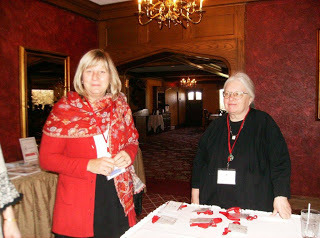 Marylee Richmond and Susan Flaherty at the registration table.Suan and Diane Judd made individual souvenirs for all participants, a series of stunning silhouettes (as below). What an acomplishment!
Marylee Richmond and Susan Flaherty at the registration table.Suan and Diane Judd made individual souvenirs for all participants, a series of stunning silhouettes (as below). What an acomplishment!
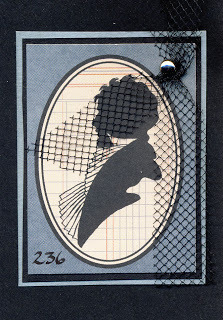
We dined on individual Beef Wellingtons or Quiches, followed by delicious desserts not to be believed. (Remember, desserts is stressed spelled backwards.) Below, Sara Bowen and Jane Glaser have a chat before the luncheon.
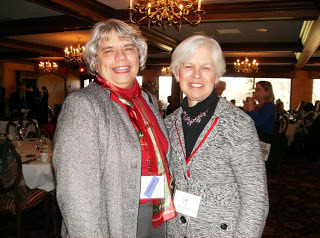
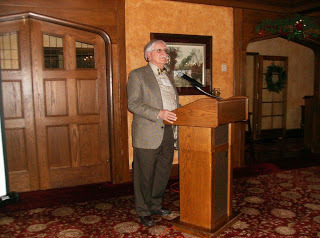
Above, our Chicago colleague, William Phillips, gave the annual toast to our favorite author's birthday.
Below, Jeff Nigro, Regional Coordinator for the neighboring Chicago group, as he presented his talk on "Austen and the Beauty of Place."
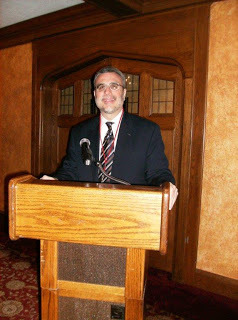
Jane Austen did not write a great many long descriptions of locations in her fiction. Sometimes, Nigro said, when characters spoke rhapsodically, their fawning images illustrated the superficial nature of the speaker, such as Mr. Collins talking of Rosings (Lady Catherine's estate) or Mrs. Elton in Emma with her inflated images of Maple Grove.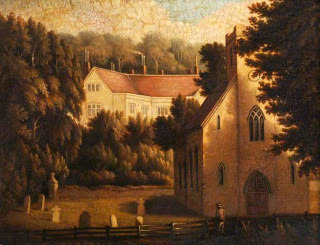 Above, Chawton House and Church, by an unknown artist
Above, Chawton House and Church, by an unknown artist
Austen favors descriptions, such as that Edward gives in Sense & Sensibility, of a landscape that unites beauty and utility. An excellent example would be the view of Wivenhoe Park by John Constable, 1816, National Gallery of Art, Washington, D. C., below.
Among the best known of Austen's landscape descriptions comes from Emma: "It was a sweet view -- sweet to the eye and the mind. English verdure, English culture, English comfort, seen under a sun bright, without being oppressive."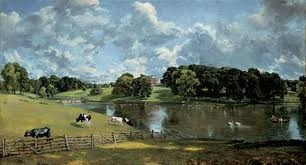
Nigro went on to compare such images from Austen to sets and locations used in various movie and television series based on the novels, sometimes finding the film version less than accurate.
Instead of trying to define a universal standard of beauty, he concluded, Austen raises queries about what constitutes true beauty; more than just a nice view, she finds perfection is based on a complex web of emotions that we bring to our personal images -- of home. Thank you, Jeff, for your stimulating talk!
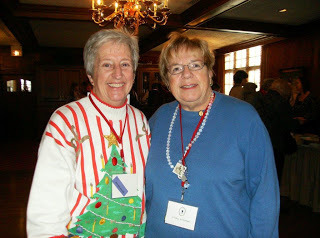 Above, Sue Zimmerman and Victoria Hinshaw
Above, Sue Zimmerman and Victoria Hinshaw
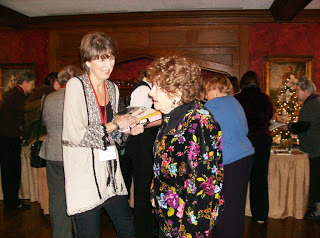 Liz Cooper with Beverly Levin
Liz Cooper with Beverly Levin
The Wisconsin Region invites you to its website, here.
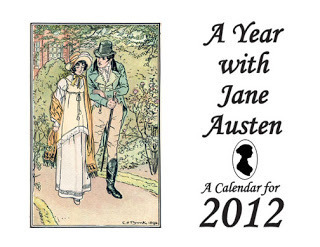 The renowned calendar prepared by Liz Philosophos Cooper and Kim Wilson has even more entries on the activities of Jane Austen, her family, and her characters to fill almost every day. This year's pictures are all on color, some of everyone's favorites from the Brock Brothers. To order, contact Liz Cooper at liz.p.cooper@gmail.comor click Merchandise on the website.
The renowned calendar prepared by Liz Philosophos Cooper and Kim Wilson has even more entries on the activities of Jane Austen, her family, and her characters to fill almost every day. This year's pictures are all on color, some of everyone's favorites from the Brock Brothers. To order, contact Liz Cooper at liz.p.cooper@gmail.comor click Merchandise on the website.
Below, a sample page (October 2012)
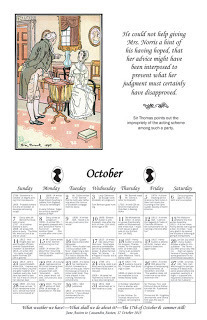

 Marylee Richmond and Susan Flaherty at the registration table.Suan and Diane Judd made individual souvenirs for all participants, a series of stunning silhouettes (as below). What an acomplishment!
Marylee Richmond and Susan Flaherty at the registration table.Suan and Diane Judd made individual souvenirs for all participants, a series of stunning silhouettes (as below). What an acomplishment!
We dined on individual Beef Wellingtons or Quiches, followed by delicious desserts not to be believed. (Remember, desserts is stressed spelled backwards.) Below, Sara Bowen and Jane Glaser have a chat before the luncheon.


Above, our Chicago colleague, William Phillips, gave the annual toast to our favorite author's birthday.
Below, Jeff Nigro, Regional Coordinator for the neighboring Chicago group, as he presented his talk on "Austen and the Beauty of Place."

Jane Austen did not write a great many long descriptions of locations in her fiction. Sometimes, Nigro said, when characters spoke rhapsodically, their fawning images illustrated the superficial nature of the speaker, such as Mr. Collins talking of Rosings (Lady Catherine's estate) or Mrs. Elton in Emma with her inflated images of Maple Grove.
 Above, Chawton House and Church, by an unknown artist
Above, Chawton House and Church, by an unknown artistAusten favors descriptions, such as that Edward gives in Sense & Sensibility, of a landscape that unites beauty and utility. An excellent example would be the view of Wivenhoe Park by John Constable, 1816, National Gallery of Art, Washington, D. C., below.
Among the best known of Austen's landscape descriptions comes from Emma: "It was a sweet view -- sweet to the eye and the mind. English verdure, English culture, English comfort, seen under a sun bright, without being oppressive."

Nigro went on to compare such images from Austen to sets and locations used in various movie and television series based on the novels, sometimes finding the film version less than accurate.
Instead of trying to define a universal standard of beauty, he concluded, Austen raises queries about what constitutes true beauty; more than just a nice view, she finds perfection is based on a complex web of emotions that we bring to our personal images -- of home. Thank you, Jeff, for your stimulating talk!
 Above, Sue Zimmerman and Victoria Hinshaw
Above, Sue Zimmerman and Victoria Hinshaw Liz Cooper with Beverly Levin
Liz Cooper with Beverly LevinThe Wisconsin Region invites you to its website, here.
 The renowned calendar prepared by Liz Philosophos Cooper and Kim Wilson has even more entries on the activities of Jane Austen, her family, and her characters to fill almost every day. This year's pictures are all on color, some of everyone's favorites from the Brock Brothers. To order, contact Liz Cooper at liz.p.cooper@gmail.comor click Merchandise on the website.
The renowned calendar prepared by Liz Philosophos Cooper and Kim Wilson has even more entries on the activities of Jane Austen, her family, and her characters to fill almost every day. This year's pictures are all on color, some of everyone's favorites from the Brock Brothers. To order, contact Liz Cooper at liz.p.cooper@gmail.comor click Merchandise on the website.Below, a sample page (October 2012)

Published on December 16, 2011 01:00
December 15, 2011
Christmas Turkeys
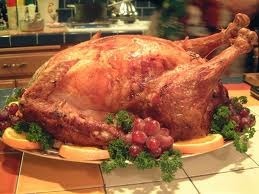
From The Book of Christmas: Descriptive of the customs, ceremonies, traditions ... By Thomas Kibble Hervey (1845)
Amongst the signs of the time that are conspicuous upon the roads, the traveller whose journeyings bring him towards those which lead into the metropolis, will be struck by the droves of cattle that are making their painful way up to the great mart, for this great festival. But a still more striking, though less noisy, Christmas symptom forms a very amusing object, to him who leaves London by such of its highways as lead eastward. Many a time have we seen a Norfolk coach, with its hampers piled on the roof and swung from beneath the body, and its birds depending, by every possible contrivance, from every part from which a bird could be made to hang. Nay, we believe it is not unusual with the proprietors, at this season, to refuse inside passengers of the human species, in favor of these oriental gentry, who "paybetter;" and, on such occasions, of course, they set at defiance the restriction which limits them to carrying "four insides." Within and without, the coaches are crammed with the bird of Turkey;—and a gentleman town-ward bound, who presented himself at a Norwich coach-office, at such a time, to inquire the "fare to London," was pertly answered by the book-keeper, "Turkeys." Our readers will acquit us of exaggeration, when we tell them that Mr. Hone, in his Every Day Book, quotes, from an historical account of Norwich, an authentic statement of the amount of turkeys which were transmitted from that city to London, between a Saturday morning and the night of Sunday, in the December of 1793;—which statement gives the number as one thousand seven hundred, the weight as nine tons, two cwt., and two lbs., and the value as £680. It is added that, in the two following days, these were followed by half as many more. We are unable to furnish the present statistics of the matter; but, in forty years which have elapsed since that time, the demand, and, of course, the supply must have greatly increased; and it is probable that the coach proprietors find it convenient to put extra carriages on the road, for these occasions.
Norfolk must be a noisy county. There must be a " pretty considerable deal" of gabble, towards the month of November, in that English Turkistan. But what a silence must have fallen upon its farm-yards, since Christmas has come round! Turkeys are indisputably born to be killed. That is an axiom. It is the end of their training,—as it ought to be (and, in one sense, certainly is) of their desires. And, such being the destiny of this bird, it may probably be an object of ambition with a respectable turkey, to fulfil its fate, at the period of this high festival. Certain it is that, at no other time, can it attain to such dignities as belong to the turkey who smokes on the well stored table of a Christmas dinner, the most honored dish of all the feast.
Published on December 15, 2011 00:53
December 14, 2011
A Day in the Life of a Queen
Creevey Papers 1838
December 15th.—Went on Wednesday to a Council at Windsor, and after the Council was invited to stay that night; rode with the Queen, and after riding Melbourne came to me and said Her Majesty wished me to stay the next day also. This was very gracious and very considerate, because it was done for the express purpose of showing that she was not displeased at my not staying when asked on a former occasion, and as she can have no object whatever in being civil to me, it was a proof of her good-nature and thoughtfulness about other people's little vanities, even those of the most insignificant. Accordingly I remained till Friday morning, when I went with the rest of her suite to see the hounds throw off, which she herself saw for the first time.
The Court is certainly not gay, but it is perhaps impossible that any Court should be gay where there is no social equality; where some ceremony, and a continual air of deference and respect must be observed, there can be no ease, and without ease there can be no real pleasure. The Queen is natural, good-humoured, and cheerful, but still she is Queen, and by her must the social habits and the tone of conversation be regulated, and for this she is too young and inexperienced. She sits at a large round table, her guests around it, and Melbourne always in a chair beside her, where two mortal hours are consumed in such conversation as can be found, which appears to be, and really is, very up-hill work. This, however, is the only bad part of the whole; the rest of the day is passed without the slightest constraint, trouble, or annoyance to anybody; each person is at liberty to employ himself or herself as best pleases them, though very little is done in common, and in this respect Windsor is totally unlike any other place. There is none of the sociability which makes the agreeableness of an English country house; there is no room in which the guests assemble, sit, lounge, and talk as they please and when they please; there is a billiard table, but in such a remote corner of the Castle that it might as well be in the town of Windsor; and there is a library well stocked with books, but hardly accessible, imperfectly warmed, and only tenanted by the librarian: it is a mere library, too, unfurnished, and offering none of the comforts and luxuries of a habitable room.
There are two breakfast rooms, one for the ladies and the guests, and the other for the equerries, but when the meal is over everybody disperses, and nothing but another meal reunites the company, so that, in fact, there is no society whatever, little trouble, little etiquette, but very little resource or amusement. The life which the Queen leads is this: she gets up soon after eight o'clock, breakfasts in her own room, and is employed the whole morning in transacting business; she reads all the despatches, and has every matter of interest and importance in every department laid before her. At eleven or twelve Melbourne comes to her and stays an hour, more or less, according to the business he may have to transact At two she rides with a large suite (and she likes to have it numerous); Melbourne always rides on her left hand, and the equerry in waiting generally on her right; she rides for two hours along the road, and the greater part of the time at a full gallop; after riding she amuses herself for the rest of the afternoon with music and singing, playing, romping with children, if there are any in the Castle (and she is so fond of them that she generally contrives to have some there), or in any other way she fancies.
The hour of dinner is nominally half-past seven o'clock, soon after which time the guests assemble, but she seldom appears till near eight. The lord in waiting comes into the drawing-room and instructs each gentleman which lady he is to take in to dinner. When the guests are all assembled the Queen comes in, preceded by the gentlemen of her household, and followed by the Duchess of Kent and all her ladies; she speaks to each lady, bows to the men, and goes immediately into the diningroom. She generally takes the arm of the man of the highest rank, but on this occasion she went with Mr. Stephenson, the American Minister (though he has no rank), which was very wisely done. Melbourne invariably sits on her left, no matter who may be there; she remains at table the usual time, but does not suffer the men to sit long after her, and we were summoned to coffee in less than a quarter of an hour. In the drawing-room she never sits down till the men make their appearance. Coffee is served to them in the adjoining room, and then they go into the drawing-room, when she goes round and says a few words to each, of the most trivial nature, all however very civil and cordial in manner and expression.
When this little ceremony is over the Duchess of Kent's whist table is arranged, and then the round table is marshalled, Melbourne invariably sitting on the left hand of the Queen and remaining there without moving till the evening is at an end. At about half-past eleven she goes to bed, or whenever the Duchess has played her usual number of rubbers, and the band have performed all the pieces on their list for the night. This is the whole history of her day: she orders and regulates every detail herself, she knows where everybody is lodged in the Castle, settles about the riding or driving, and enters into every particular with minute attention. But while she personally gives her orders to her various attendants, and does everything that is civil to all the inmates of the Castle, she really has nothing to do with anybody but Melbourne, and with him she passes (if not in tete-a-tete yet in intimate communication) more hours than any two people, in any relation of life, perhaps ever do pass together besides (1) He is at her side for at least six hours every day— an hour in the morning, two on horseback, one at dinner, and two in the evening. This monopoly is certainly not judicious; it is not altogether consistent with social usage, and it leads to an infraction of those rules of etiquette which it is better to observe with regularity at Court. But it is more peculiarly inexpedient with reference to her own future enjoyment, for if Melbourne should be compelled to resign, her privation will be the more bitter on account of the exclusiveness of her intimacy with him. Accordingly, her terror when any danger menaces the Government, her nervous apprehension at any appearance of change, affect her health, and upon one occasion during the last session she actually fretted herself into an illness at the notion of their going out. It must be owned that her feelings are not unnatural, any more than those which Melbourne entertains towards her. His manner to her is perfect, always respectful, and never presuming upon the extraordinary distinction he enjoys; hers to him is simple and natural, indicative of the confidence she reposes in him, and of her lively taste for his society, but not marked by any unbecoming familiarity.
Interesting as his position is, and flattered, gratified, and touched as he must be by the confiding devotion with which she places herself in his hands, it is still marvellous that he should be able to overcome the force of habit so completely as to endure the life he leads. Month after month he remains at the Castle, submitting to this daily routine: of all men he appeared to be the last to be broken in to the trammels of a Court, and never was such a revolution seen in anybody's occupations and habits. Instead of indolently sprawling in all the attitudes of luxurious ease, he is always sitting bolt upright; his free and easy language interlarded with 'damns' is carefully guarded and regulated with the strictest propriety, and he has exchanged the good talk of Holland House for the trivial, laboured, and wearisome inanities of the Royal circle.
1 The Duke of Wellington says that Melbourne is quite right to go and stay at the Castle as much he does, and that it is very fit he should instruct the young Queen in the business of government, but he disapproves of his being always at her side, even contrary to the rules of etiquette; for ae a Prime Minister has no precedence, he ought not to be placed in the post of honour to the exclusion of those of higher rank than himself.
December 15th.—Went on Wednesday to a Council at Windsor, and after the Council was invited to stay that night; rode with the Queen, and after riding Melbourne came to me and said Her Majesty wished me to stay the next day also. This was very gracious and very considerate, because it was done for the express purpose of showing that she was not displeased at my not staying when asked on a former occasion, and as she can have no object whatever in being civil to me, it was a proof of her good-nature and thoughtfulness about other people's little vanities, even those of the most insignificant. Accordingly I remained till Friday morning, when I went with the rest of her suite to see the hounds throw off, which she herself saw for the first time.
The Court is certainly not gay, but it is perhaps impossible that any Court should be gay where there is no social equality; where some ceremony, and a continual air of deference and respect must be observed, there can be no ease, and without ease there can be no real pleasure. The Queen is natural, good-humoured, and cheerful, but still she is Queen, and by her must the social habits and the tone of conversation be regulated, and for this she is too young and inexperienced. She sits at a large round table, her guests around it, and Melbourne always in a chair beside her, where two mortal hours are consumed in such conversation as can be found, which appears to be, and really is, very up-hill work. This, however, is the only bad part of the whole; the rest of the day is passed without the slightest constraint, trouble, or annoyance to anybody; each person is at liberty to employ himself or herself as best pleases them, though very little is done in common, and in this respect Windsor is totally unlike any other place. There is none of the sociability which makes the agreeableness of an English country house; there is no room in which the guests assemble, sit, lounge, and talk as they please and when they please; there is a billiard table, but in such a remote corner of the Castle that it might as well be in the town of Windsor; and there is a library well stocked with books, but hardly accessible, imperfectly warmed, and only tenanted by the librarian: it is a mere library, too, unfurnished, and offering none of the comforts and luxuries of a habitable room.
There are two breakfast rooms, one for the ladies and the guests, and the other for the equerries, but when the meal is over everybody disperses, and nothing but another meal reunites the company, so that, in fact, there is no society whatever, little trouble, little etiquette, but very little resource or amusement. The life which the Queen leads is this: she gets up soon after eight o'clock, breakfasts in her own room, and is employed the whole morning in transacting business; she reads all the despatches, and has every matter of interest and importance in every department laid before her. At eleven or twelve Melbourne comes to her and stays an hour, more or less, according to the business he may have to transact At two she rides with a large suite (and she likes to have it numerous); Melbourne always rides on her left hand, and the equerry in waiting generally on her right; she rides for two hours along the road, and the greater part of the time at a full gallop; after riding she amuses herself for the rest of the afternoon with music and singing, playing, romping with children, if there are any in the Castle (and she is so fond of them that she generally contrives to have some there), or in any other way she fancies.
The hour of dinner is nominally half-past seven o'clock, soon after which time the guests assemble, but she seldom appears till near eight. The lord in waiting comes into the drawing-room and instructs each gentleman which lady he is to take in to dinner. When the guests are all assembled the Queen comes in, preceded by the gentlemen of her household, and followed by the Duchess of Kent and all her ladies; she speaks to each lady, bows to the men, and goes immediately into the diningroom. She generally takes the arm of the man of the highest rank, but on this occasion she went with Mr. Stephenson, the American Minister (though he has no rank), which was very wisely done. Melbourne invariably sits on her left, no matter who may be there; she remains at table the usual time, but does not suffer the men to sit long after her, and we were summoned to coffee in less than a quarter of an hour. In the drawing-room she never sits down till the men make their appearance. Coffee is served to them in the adjoining room, and then they go into the drawing-room, when she goes round and says a few words to each, of the most trivial nature, all however very civil and cordial in manner and expression.
When this little ceremony is over the Duchess of Kent's whist table is arranged, and then the round table is marshalled, Melbourne invariably sitting on the left hand of the Queen and remaining there without moving till the evening is at an end. At about half-past eleven she goes to bed, or whenever the Duchess has played her usual number of rubbers, and the band have performed all the pieces on their list for the night. This is the whole history of her day: she orders and regulates every detail herself, she knows where everybody is lodged in the Castle, settles about the riding or driving, and enters into every particular with minute attention. But while she personally gives her orders to her various attendants, and does everything that is civil to all the inmates of the Castle, she really has nothing to do with anybody but Melbourne, and with him she passes (if not in tete-a-tete yet in intimate communication) more hours than any two people, in any relation of life, perhaps ever do pass together besides (1) He is at her side for at least six hours every day— an hour in the morning, two on horseback, one at dinner, and two in the evening. This monopoly is certainly not judicious; it is not altogether consistent with social usage, and it leads to an infraction of those rules of etiquette which it is better to observe with regularity at Court. But it is more peculiarly inexpedient with reference to her own future enjoyment, for if Melbourne should be compelled to resign, her privation will be the more bitter on account of the exclusiveness of her intimacy with him. Accordingly, her terror when any danger menaces the Government, her nervous apprehension at any appearance of change, affect her health, and upon one occasion during the last session she actually fretted herself into an illness at the notion of their going out. It must be owned that her feelings are not unnatural, any more than those which Melbourne entertains towards her. His manner to her is perfect, always respectful, and never presuming upon the extraordinary distinction he enjoys; hers to him is simple and natural, indicative of the confidence she reposes in him, and of her lively taste for his society, but not marked by any unbecoming familiarity.
Interesting as his position is, and flattered, gratified, and touched as he must be by the confiding devotion with which she places herself in his hands, it is still marvellous that he should be able to overcome the force of habit so completely as to endure the life he leads. Month after month he remains at the Castle, submitting to this daily routine: of all men he appeared to be the last to be broken in to the trammels of a Court, and never was such a revolution seen in anybody's occupations and habits. Instead of indolently sprawling in all the attitudes of luxurious ease, he is always sitting bolt upright; his free and easy language interlarded with 'damns' is carefully guarded and regulated with the strictest propriety, and he has exchanged the good talk of Holland House for the trivial, laboured, and wearisome inanities of the Royal circle.
1 The Duke of Wellington says that Melbourne is quite right to go and stay at the Castle as much he does, and that it is very fit he should instruct the young Queen in the business of government, but he disapproves of his being always at her side, even contrary to the rules of etiquette; for ae a Prime Minister has no precedence, he ought not to be placed in the post of honour to the exclusion of those of higher rank than himself.
Published on December 14, 2011 00:14
December 12, 2011
JASNA Birthday Tea in Chicago
The Greater Chicago Chapter of JASNA celebrated Jane Austen's 236th birthday with toasts to Jane and tea at the Fortnightly on Saturday, December 3, 2011. The Club was festive with Christmas lights and set a perfect atmosphere for our afternoon.
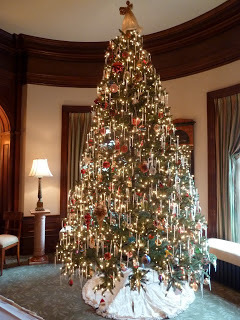
The speaker for the program was Mona Scheuermann, a professor at Oakton Community College in Illinois, whose topic was "Jane Austen and Making Do." Of particular interest to her was the morality of the choice of plays chosen to be performed by the young people in the novel Mansfield Park. The choice of "Lover's Vows," an adaptation by Elizabeth Inchbald of a German play by von Koetzbue, defined each character and gave us a strong insight into their views.
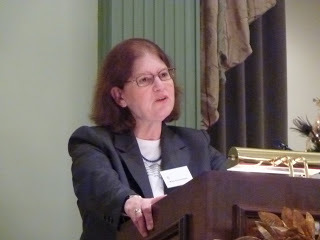
Jane Austen, according to Scheuermann, did not believe that this play, with its theme of redemption after a illicit affair, was a proper vehicle for the young, unmarried participants in the Mansfield Park dramatic effort. Fanny Price, of course, refused to participate, and Edmund also balked, placing them in the forefront of good behavior, always a value to Jane Austen.
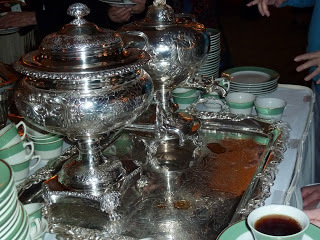
The Club's lovely silver urns for our tea. Our favorite winter beverage was accompanied by an assortment of savory sandwiches and sweets, as shown.
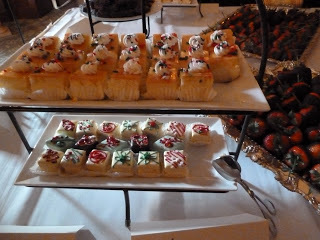
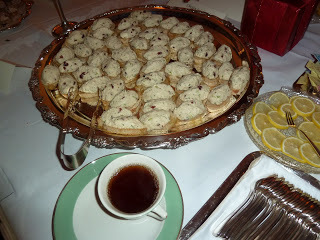
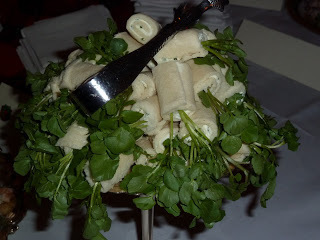
Above, the required watercress and cucumber sandwiches. Once we are all served and reassembled, it was time for the annual birthday toast to our Jane. Leading us in extolling our favorite author was Karen Doornebos, author of the new novel, Definitely Not, Mr. Darcy. Look for more information on Karen here.
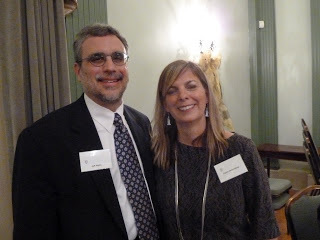
After we raised our champagne glasses to the memory of Austen, Karen posed with JASNA GCR regional coordinator Jeff Nigro.
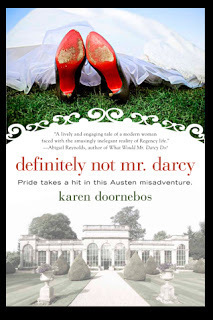
Another debut author showing off her new work was Elizabeth Lenckos of the University of Chicago, who is a contributor to the volume entitled Wooing Mr. Wickham, a collection of stories inspired by Jane Austen's heroes and villains, from the Jane Austen Short Story Award 2011 entries, sponsored by the Chawton House Library. A total of 20 authors are included in a wide variety of formats and approaches.
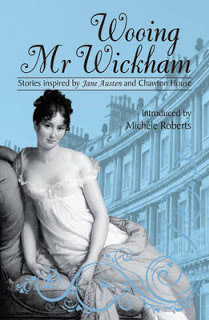
Elizabeth's story is based on the wartime experiences of her family in Berlin at the end of World War II. It is a poignant story that shows just how deeply the love of Jane Austen can dwell within our hearts, even at the worst moments of existence.
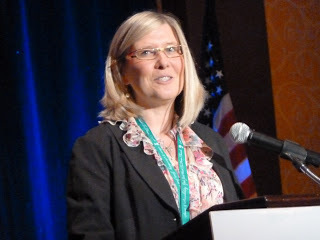
Above, Elizabeth Lenckos speaks to the JASNA AGM in Ft. Worth, TX, in October 2011.
So now you have two books to add to your list for Santa this year. And I have another Jane Austen Birthday Celebration to attend soon. Hurrah!! Regardless of various kerfluffles about murder charges and newly-discovered portraits of somebody or other, our essential love of and admiration of Jane Austen remains indiminished.

The speaker for the program was Mona Scheuermann, a professor at Oakton Community College in Illinois, whose topic was "Jane Austen and Making Do." Of particular interest to her was the morality of the choice of plays chosen to be performed by the young people in the novel Mansfield Park. The choice of "Lover's Vows," an adaptation by Elizabeth Inchbald of a German play by von Koetzbue, defined each character and gave us a strong insight into their views.

Jane Austen, according to Scheuermann, did not believe that this play, with its theme of redemption after a illicit affair, was a proper vehicle for the young, unmarried participants in the Mansfield Park dramatic effort. Fanny Price, of course, refused to participate, and Edmund also balked, placing them in the forefront of good behavior, always a value to Jane Austen.

The Club's lovely silver urns for our tea. Our favorite winter beverage was accompanied by an assortment of savory sandwiches and sweets, as shown.



Above, the required watercress and cucumber sandwiches. Once we are all served and reassembled, it was time for the annual birthday toast to our Jane. Leading us in extolling our favorite author was Karen Doornebos, author of the new novel, Definitely Not, Mr. Darcy. Look for more information on Karen here.

After we raised our champagne glasses to the memory of Austen, Karen posed with JASNA GCR regional coordinator Jeff Nigro.

Another debut author showing off her new work was Elizabeth Lenckos of the University of Chicago, who is a contributor to the volume entitled Wooing Mr. Wickham, a collection of stories inspired by Jane Austen's heroes and villains, from the Jane Austen Short Story Award 2011 entries, sponsored by the Chawton House Library. A total of 20 authors are included in a wide variety of formats and approaches.

Elizabeth's story is based on the wartime experiences of her family in Berlin at the end of World War II. It is a poignant story that shows just how deeply the love of Jane Austen can dwell within our hearts, even at the worst moments of existence.

Above, Elizabeth Lenckos speaks to the JASNA AGM in Ft. Worth, TX, in October 2011.
So now you have two books to add to your list for Santa this year. And I have another Jane Austen Birthday Celebration to attend soon. Hurrah!! Regardless of various kerfluffles about murder charges and newly-discovered portraits of somebody or other, our essential love of and admiration of Jane Austen remains indiminished.
Published on December 12, 2011 02:00
December 10, 2011
My Father's 100th Birthday
Victoria, here, wishing Happy Birthday to Gerald Malcolm Biggers (1911-1979), my esteemed father, long gone to his Great Reward. He would have been 100 years old today.
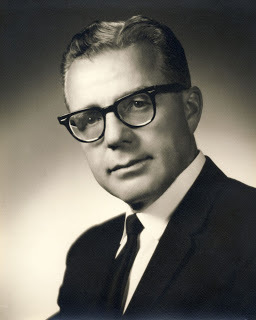 Gerald M. "Jerry" Biggers, 1964
Gerald M. "Jerry" Biggers, 1964
I have occasionally tried to trace the stories of our ancestors and, as you will see, I have had some successes. But I have been unable to link the earliest Biggers I can claim --in Maysville, Kentucky, in the early decades of the 19th century -- to his father or grandfathers who came originally from England and/or Scotland before 1776. There were several men with the surname Biggers (or something very similar) in the Virginia Militia before the American Revolution, but I lack the link to the Maysville Biggers, specifically to Harvey Poindexter Biggers, born April 3, 1819 in Kentucky and died August 3, 1879 in Albion, IL.
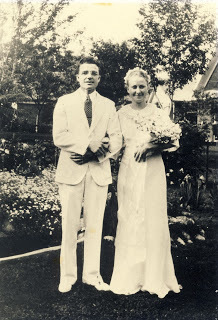 Gerald and Leone Lagerstrom Biggers, June, 1935
Gerald and Leone Lagerstrom Biggers, June, 1935
However, my cousin Shera Biggers Thompson (1939-2009) and I did find our connections to another branch of the family, the wife of our great grandfather John Biggers, Ellen Metcalfe. Her grandfather, Edward Barnard Metcalfe, was a map maker who traveled with the British Army in the Peninsular war, up to and including the Battle of Waterloo. After the war, he worked for the Ordnance Survey and taught at the Royal Engineers College. About a dozen of his exquisitely drawn maps are in the UK's National Archives at Kew, where Shera and I were privileged to see them a few years ago. The second son, Arthur, came to the US to farm in the 1820's. I assume Arthur was named in honor of Arthur Wellesley, first Duke of Wellington, for whom Edward Barnard Metcalfe had made most of his maps.
I have lots more research to do if I am to complete the picture of this family -- other names that figure into my ancestry are Poindexter (familiar to many Virignians), Heck, and Stanley (supposedly shirt-tail relatives of the earls of Derby, but more likely just some poor Yorkshiremen who took the name of the local bigwigs).
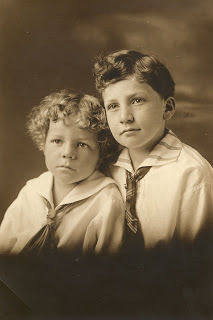 Brothers Gerald and Hayward Biggers, c. 1916
Brothers Gerald and Hayward Biggers, c. 1916
One of my father's grandfathers was George Washington Stanley, who was the sheriff of Edwards County, IL, before the turn of the 19th to the 20th century. Below, the Albion, IL, county courthouse of Edwards County and the location of this tiny county in southern Illinois, due east of St Louis on the Wabash River, the eastern boundary of Illinois with Indiana.
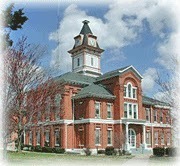

I think the greatest hero to my dad's thinking was Winston Churchill, the man who saved civilization, in his opinion, with the assistance of the forces of the Commonwealth and the U.S. for sure. I still have several volumes of Churchill's series The Second World War that belonged to my father.
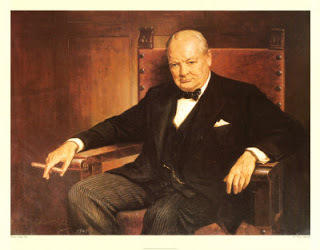 Jerry Biggers, Sr., my father, had a successful business career as a Chevrolet Dealer in Elgin, IL. He was, in my estimation, a perfect father. He was devoted to his wife, to me and to my brother, Jerry Jr. He loved our spouses and our children. He was a member of many civic improvement organizations in Elgin and later in his life, in Key Colony Beach, FL, where he lived in retirement. As his friends and colleagues knew, if you wanted a job done, Jerry would accomplish it.
Jerry Biggers, Sr., my father, had a successful business career as a Chevrolet Dealer in Elgin, IL. He was, in my estimation, a perfect father. He was devoted to his wife, to me and to my brother, Jerry Jr. He loved our spouses and our children. He was a member of many civic improvement organizations in Elgin and later in his life, in Key Colony Beach, FL, where he lived in retirement. As his friends and colleagues knew, if you wanted a job done, Jerry would accomplish it.
Though he had a great interest in all things British, he and Mother traveled to Europe only once, visiting England, Scotland and Sweden, where my mother's parents came from. I particularly remember him talking about his visit to the Tower of London and Westminster Abbey as well as the town of Biggar in Scotland, from which he believed some of his ancestors had emigrated.
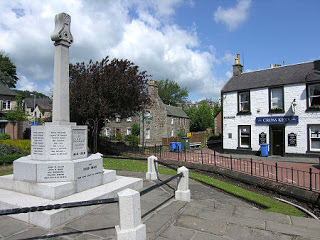 Biggar, Scotland
Biggar, Scotland
My father was a great devotee of classical music and loved to listen to his recordings in the evening with his bourbon and a detective novel. We always wondered of the author Earl Derr Biggers, creator of Charlie Chan, was related to us somehow. Probably his favorite writer was Erle Stanley Gardner, creator of Perry Mason, and perhaps another distant - really distant -- Stanley relation.
To my darling daddy, Happy 100th Birthday!
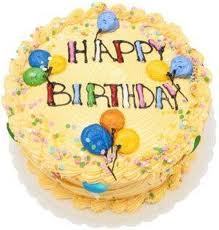

 Gerald M. "Jerry" Biggers, 1964
Gerald M. "Jerry" Biggers, 1964I have occasionally tried to trace the stories of our ancestors and, as you will see, I have had some successes. But I have been unable to link the earliest Biggers I can claim --in Maysville, Kentucky, in the early decades of the 19th century -- to his father or grandfathers who came originally from England and/or Scotland before 1776. There were several men with the surname Biggers (or something very similar) in the Virginia Militia before the American Revolution, but I lack the link to the Maysville Biggers, specifically to Harvey Poindexter Biggers, born April 3, 1819 in Kentucky and died August 3, 1879 in Albion, IL.
 Gerald and Leone Lagerstrom Biggers, June, 1935
Gerald and Leone Lagerstrom Biggers, June, 1935However, my cousin Shera Biggers Thompson (1939-2009) and I did find our connections to another branch of the family, the wife of our great grandfather John Biggers, Ellen Metcalfe. Her grandfather, Edward Barnard Metcalfe, was a map maker who traveled with the British Army in the Peninsular war, up to and including the Battle of Waterloo. After the war, he worked for the Ordnance Survey and taught at the Royal Engineers College. About a dozen of his exquisitely drawn maps are in the UK's National Archives at Kew, where Shera and I were privileged to see them a few years ago. The second son, Arthur, came to the US to farm in the 1820's. I assume Arthur was named in honor of Arthur Wellesley, first Duke of Wellington, for whom Edward Barnard Metcalfe had made most of his maps.
I have lots more research to do if I am to complete the picture of this family -- other names that figure into my ancestry are Poindexter (familiar to many Virignians), Heck, and Stanley (supposedly shirt-tail relatives of the earls of Derby, but more likely just some poor Yorkshiremen who took the name of the local bigwigs).
 Brothers Gerald and Hayward Biggers, c. 1916
Brothers Gerald and Hayward Biggers, c. 1916One of my father's grandfathers was George Washington Stanley, who was the sheriff of Edwards County, IL, before the turn of the 19th to the 20th century. Below, the Albion, IL, county courthouse of Edwards County and the location of this tiny county in southern Illinois, due east of St Louis on the Wabash River, the eastern boundary of Illinois with Indiana.


I think the greatest hero to my dad's thinking was Winston Churchill, the man who saved civilization, in his opinion, with the assistance of the forces of the Commonwealth and the U.S. for sure. I still have several volumes of Churchill's series The Second World War that belonged to my father.
 Jerry Biggers, Sr., my father, had a successful business career as a Chevrolet Dealer in Elgin, IL. He was, in my estimation, a perfect father. He was devoted to his wife, to me and to my brother, Jerry Jr. He loved our spouses and our children. He was a member of many civic improvement organizations in Elgin and later in his life, in Key Colony Beach, FL, where he lived in retirement. As his friends and colleagues knew, if you wanted a job done, Jerry would accomplish it.
Jerry Biggers, Sr., my father, had a successful business career as a Chevrolet Dealer in Elgin, IL. He was, in my estimation, a perfect father. He was devoted to his wife, to me and to my brother, Jerry Jr. He loved our spouses and our children. He was a member of many civic improvement organizations in Elgin and later in his life, in Key Colony Beach, FL, where he lived in retirement. As his friends and colleagues knew, if you wanted a job done, Jerry would accomplish it.Though he had a great interest in all things British, he and Mother traveled to Europe only once, visiting England, Scotland and Sweden, where my mother's parents came from. I particularly remember him talking about his visit to the Tower of London and Westminster Abbey as well as the town of Biggar in Scotland, from which he believed some of his ancestors had emigrated.
 Biggar, Scotland
Biggar, ScotlandMy father was a great devotee of classical music and loved to listen to his recordings in the evening with his bourbon and a detective novel. We always wondered of the author Earl Derr Biggers, creator of Charlie Chan, was related to us somehow. Probably his favorite writer was Erle Stanley Gardner, creator of Perry Mason, and perhaps another distant - really distant -- Stanley relation.
To my darling daddy, Happy 100th Birthday!

Published on December 10, 2011 02:00
December 8, 2011
Speaking of Bridget Jones . . . .
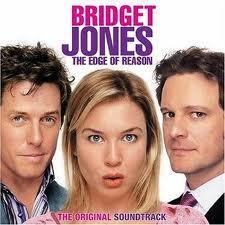
Okay, holiday season is upon us and by now you've most likely already watched Bridget Jones's Diary a few times (haven't you?) It's time now to move on to Bridget Jones: The Edge of Reason. Go on, dust off your dvd and start watching, but before you do, watch the movie trailer here first.
Published on December 08, 2011 00:45
Kristine Hughes's Blog
- Kristine Hughes's profile
- 6 followers
Kristine Hughes isn't a Goodreads Author
(yet),
but they
do have a blog,
so here are some recent posts imported from
their feed.



